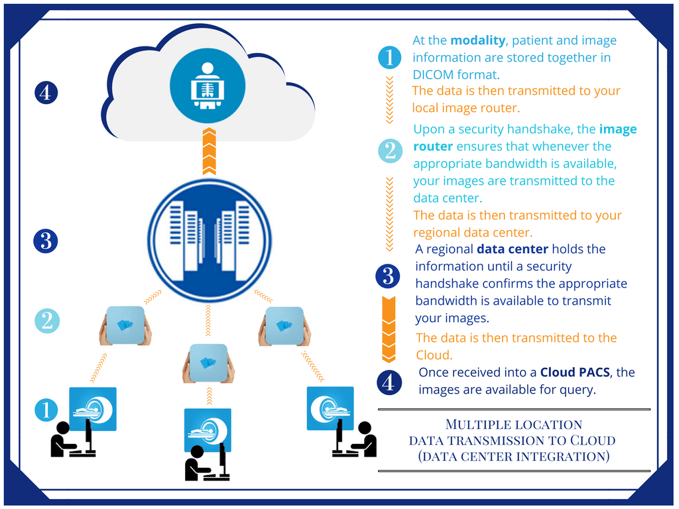How To Optimize Cloud PACS Usage At Multi-Site Medical Practices


We often encounter practices with modalities in several practice locations. Sometimes reads occur in one or several of these locations, requiring studies to be transmitted from the office where a modality resides to that where the read will take place. Most organizations find it optimal to maintain a single master repository that cumulates the images from each of their locations. This makes it much easier to archive, backup and locate studies, no matter which location a patient visited. Often today this idea of centralization implies utilizing a cloud based architecture.
How Are Multiple Locations Connected?
There are two different ways to electronically connect multiple locations. You can either create a direct point-to-point communication bridge between these locations using a WAN, or you can connect all of your locations to a centralized data center using a hub and spoke topology...sometimes requiring a VPN for security and privacy.
If your reads are required immediately after the scans are completed, then you probably want to directly connect those locations via a WAN. With a WAN, the speed of your connection is generally predictable and you are not subject to interruption when the Internet encounters issues. Even extremely large images like tomosynthesis can appear within minutes on the other end of a WAN connection. Essentially, all of your locations can be connected via your local internet service provider (ISP) to a centralized PACS server in the Cloud.
Have a single practice location? Read This. 
Optimizing Connections
Each site that is connected via the internet should connect via a local image router. The router can play multiple roles to enhance internet communication. First, it buffers transmission so that any slowdowns or interruptions in internet connectivity do not impede the flow of images between your locations. Second, it can compress the size of the files before they are sent, optimizing transmission speeds. Third, it monitors and audits the receipt and transmission of images, ensuring that nothing gets lost between the two points. And fourth, it can obviate the need for a VPN. Thats right - when there is an image router on both sides of the transmission, secure and private transmission can be accomplished without the need for a VPN.
Take A Closer Look
In the diagram you can see the the path that your medical imaging takes when you include a data center into your multi-site medical practice's architecture. So, first thing’s first: your data originates within the modality. The imaging data is managed by a local image router or temporary PACS to ensure quick reads and data integrity. That data can actually be made available to the radiologist or other specialist who then reads the study and generates a report - and if that read is required in a timely manner, those sites are often connected via a WAN. Once read, the study together with the report is transmitted to the central cloud PACs via a data center: where it can be access and archived for future use. So in short, all of your sites connect to a centralized data center. Upon a security handshake where the data center is alerted there is sufficient bandwidth for a transmission, your data is sent to the cloud. Voila!

Final Thought
With a thoughtful architecture, a central cloud PACS can provide your multiple practice locations with a robust, predictable and efficient way to access and archive your medical images. Using the Cloud as that central repository also makes sharing, collaboration and mobile access a natural part of your PACS strategy. Done right, a central Cloud PACS can provide you with a host of benefits without slowing down or interfering with your established workflow.


